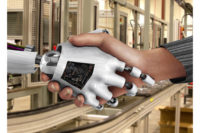No matter where or how it’s applied, the ultimate goal of flexible manufacturing is always the same: Greater responsiveness to customer demands, in addition to reduced changeover time and quicker time to market. But, exactly how much equipment reconfiguring and reuse can be done, and how much it costs, is subject to debate.
Manufacturing engineers must address several myths and misperceptions that surround flexibility. For instance, some people believe that you can’t be truly flexible without using a lot of automation. However, flexible assembly lines often feature a combination of manual and automated systems.
“A flexible factory [does not need] to be highly automated,” says Frank Chen, Ph.D., director of the Center for Advanced Manufacturing & Lean Systems at the University of Texas at San Antonio. “It [requires] the intelligent use of automation and human resources for the production of goods and services to timely serve customers. [You] can quickly gain flexibility by implementing some lean manufacturing tools, such as cross-training and standardized work instructions. The challenge is the lack of advanced planning, scheduling and control systems available for running a flexible factory.”
A variety of production factors, such as quantity, variation, predictability, cycle time, part size and process complexity, all influence the type of equipment best suited for a flexible assembly line. The first step is to identify the most important factors to a specific application.
“I don’t see manufacturers thinking about flexibility as a bonus, but a requirement,” says Bob Rice, team leader for applications engineering at Automation Tool Co. (Cookeville, TN). “That is to say they think of it only if it as necessary to justify the program. Few are willing to pay extra to have the flexibility to address the future requirements.”
“Today, flexibility is most commonly associated with lean manufacturing and manual production systems,” notes Mark Dinges, product marketing manager for linear motion and assembly technologies at Bosch Rexroth Corp. (Buchanan, MI). “While manual production may be the optimal solution for some assembly applications, other applications are better served with a mix of manual and automated systems, and still others may benefit most from a completely automated approach.
“One of the keys to a flexible production system is to have modular equipment,” adds Dinges. For example, conveyors and workstations should be constructed from bolt-together components and aluminum structural framing. “This modular design allows for greater flexibility by allowing the combination of manual and automated workstations on the same conveyor system,” Dinges points out. “It also allows for simple line reconfiguration, expansions or complete redeployment to another location.”
“Another common misperception is, if you increase flexibility, you increase complexity, because there will be more changeovers,” notes Amyn Merchant, senior partner and managing director of the New York office of the Boston Consulting Group Inc. (Boston). “That’s often not the case at all. It’s only true in about 20 percent to 25 percent of the plants out there – primarily facilities that make mass-market products.”
In addition, customer demand is often not as predictable as manufacturers would like. “The events of the last six months have shown us that demand can drop off extremely suddenly,” explains Dinges. “Even the most flexible factory in the world has trouble adjusting to those types of dramatic changes with existing infrastructure.”
Another big challenge is knowing what types of flexible production equipment to invest in. “The capability and tools are available, but achieving a truly flexible factory still requires forethought on how to use the technology,” claims Lou Mello, global segment business manager for assembly, manufacturing and alternative energy OEMs at Rockwell Automation Inc. (Milwaukee). “[You also need to have] the technical resources to implement flexible manufacturing systems. It requires talented engineers with mechanical, electrical and IT skill sets.

